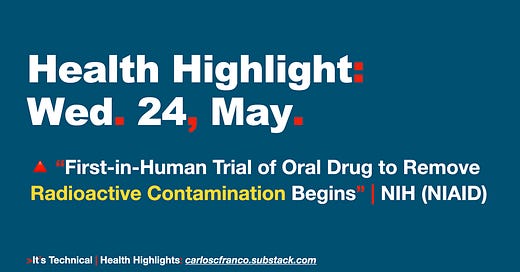Health Highlight: Wed. 24, May.
Today’s Highlight(s): Today, we examine another NIH|NIAID phase 1 clinical trial on a drug to improve radioactive contamination treatment ☢️.
Health Highlights workflow is powered by Glasp.co and Perplexity.ai; produced using iA Writer and Keynote.
Have a question? Want to be a sponsor? Get in touch: carlosfranco.bio
🧠 Learn, ❤️ Like, 🤝 Share, and 📩 Subscribe!

THE BRIEF
In a May 15th press release, the National Institute of Allergy and Infectious Diseases (NIAID) announced that it is funding a first-in-human (FIH) clinical trial aimed at improving current internal radioactive contamination treatments.
The investigational drug HOPO 14–1, is designed as an oral capsule and is intended to help clear radioactive elements from the body.

Key Points
The trial will examine the processing, safety, and tolerability of increasing doses of the medication in healthy adults.
42 participants will be divided into seven groups by the study team, and each group will receive progressively higher doses of the study drug, with the final group receiving 7500 mg.
Results are anticipated by 2024.
Double-click
What is internal contamination, and how does it happen?
“Internal contamination occurs when people swallow or breathe in radioactive materials, or when radioactive materials enter the body through an open wound or are absorbed through the skin.” 1
Figure 1. A pictograph of areas affected by internal contamination
“This could happen as the result of a nuclear power plant accident or the detonation of a ‘dirty bomb’ or nuclear weapon.” 2
Two intravenous medications are currently FDA-approved for the treatment of internal radiation contamination, Ca-DTPA and Zn-DTPA3 but because they are administered via IV or nebulizer, they have storage limitations as well as barriers to being used without medical assistance.
“The Food and Drug Administration has approved two products for removing internal radioactive contamination. These drugs, both based on diethylenetriamine pentaacetate (DTPA), are administered intravenously by a healthcare provider and can remove three radioactive elements: plutonium, americium, and curium.” 2
More
Study of Single Oral Doses of HOPO 14–1 Evaluating Safety, Tolerability, Pharmacokinetics [clinicaltrials.gov]
The study objectives are to define the safety and tolerability profile of oral, single ascending dose (SAD) levels of HOPO 14–1 capsules in cohorts of healthy participants and to assess the pharmacokinetic (PK) and excretion profile of HOPO 14–1. The study hypothesis is that a single dose of HOPO 14–1 will be safe and tolerable up to 7500 mg.FDA Approves Drugs to Treat Internal Contamination from Radioactive Elements [fda.gov]
The Food and Drug Administration (FDA) today announced the approval of two drugs, pentetate calcium trisodium injection (Ca-DTPA) and pentetate zinc trisodium injection (Zn-DTPA) for treating certain kinds of radiation contamination.Questions and Answers on Calcium-DTPA and Zinc-DTPA (Updated)[fda.gov]
Calcium-DTPA (Ca-DTPA) and Zinc-DTPA (Zn-DTPA) are drug products that have been used investigationally for over 40 years to speed up excretion of the transuranium elements plutonium, americium, and curium from the body.“Bioterrorism and Drug Preparedness: Radiation Emergencies” [fda.gov]
Keywords 🏷️: #Radiation #RadiologicalContamination #NuclearAccident #ClinicalTrial #NIH #NIAID #FDANOTES
“Radiation Emergencies: Contamination vs. Exposure” https://www.cdc.gov/nceh/radiation/emergencies/contamination.htm
“First-in-Human Trial of Oral Drug to Remove Radioactive Contamination Begins: NIH-Funded Clinical Trial Will Determine Safety, Tolerability of Experimental Drug” https://www.niaid.nih.gov/news-events/first-human-trial-oral-drug-remove-radioactive-contamination-begins
“Managing Internal Contamination: Ca-DTPA/Zn-DTPA (Diethylentriamene pentaacetate)”
https://remm.hhs.gov/dtpa.htm





